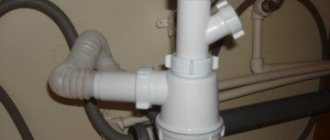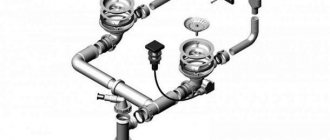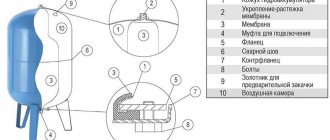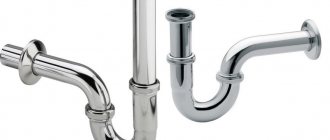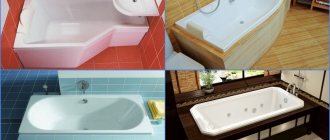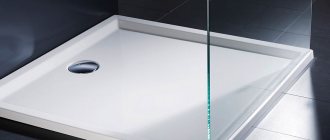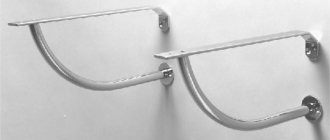- What it is
- Main functions
- Main device
- Operating principle
- Varieties
- Bottle type design
- Corrugated type device
- Pipe structure device
Plumbing fixtures are one of the most important items for normal human life. It’s hard to imagine, but just recently humanity managed without a sewer system. Nowadays, technological progress has gone so far that the organization of sewerage activities has become fully automated and requires virtually no human intervention. The main conductor connecting the sewer system and the plumbing fixture is the siphon. However, few can explain how it works and how it does its work. In fact, the principle of operation of the siphon is quite simple. It is based on the basic laws of physics.
Operating principles of siphons
What it is
The siphon is an integral part of the design of plumbing equipment. It is usually a curved vessel designed to control the liquid level.
Main purpose: ensuring the flow of filtered liquid into the sewer system. Its curved shape protects the sewer system from contamination by household waste that gets inside the plumbing equipment.
Many people mistakenly believe that it is a built-in part of plumbing equipment (sinks, bathtubs). In fact, this is fundamentally not true. The device is an independent device with a complex design mechanism.
Step-by-step installation process
Before deciding on a specific model, you must first take all measurements, in particular, measure the space at the bottom of the sink . In addition, it is worth carefully analyzing what equipment will be installed in the room in the future and whether it will need draining.
Installation of the selected model must be carried out according to the instructions provided by the manufacturer and located in each box with the product. Thanks to the detailed information, the installation process will not take much time and will not require any specialized knowledge. The main requirement for assembly is the tightness of the connections between each part. Before making a purchase, it is advisable to check the condition of the threads on the bottom plug. It is this place that is the weak link in most models.
Installing a siphon on a sink:
- at the bottom of the sink, you need to put a grille and secure it with a nut.
- the assembled structure is directed to the drain to secure the connection with a locking nut. It is not twisted very tightly, just until it stops.
- When installing a water pipeline with several holes, for future installation of other equipment, unused drainage systems must be closed with plugs.
Although the process seems quite easy, it still requires analytical skills and some experience. To avoid leaks or other problems, you should contact installers who have extensive experience in this field. They will provide a warranty, perform all the work quickly and efficiently, using modern equipment.
Main device
Let's look at the main structure of the siphon. Its design consists of several interconnected parts. Let us note the most important of them:
- outer casing;
Siphon device - socket to provide insulation;
- outlet pipe for connecting to the sewer;
- outlet pipe for liquid drainage;
- square;
- rubber gasket;
- protective mesh for filtration;
- screw for connection;
- overlays.
What materials are the devices made from?
Various materials are used in the production of siphons. Each of them has its own advantages and disadvantages. When choosing a suitable device, it is important to make sure that the material from which it is made is quite durable, resistant to corrosion and oxidation. Its service life depends on these characteristics.
Available plastic products
Plastic siphons are the cheapest and most common devices with a simple design and a small number of connections.
Devices are made from PVC, polyethylene, polypropylene. The latter option is preferable, as it lasts longer, has better strength and is less sensitive to high temperatures.
The range of PVC products includes improved branched models designed for two-section sinks and side-by-side sinks
Thanks to the smooth and even inner surface, impurities contained in the water are not deposited on the walls. Some manufacturers apply antibacterial coatings to the cavity to prevent strong sedimentation of dirt and grease.
Plastic products are very flexible. Most of them are equipped with bendable corrugated bends, which quickly take the shape required for installation.
Durable metal devices
In the manufacture of metal products, brass, bronze, copper, and chrome plating are used. They stand out for their stylish design, which perfectly complements luxury interiors.
High-tech bronze products look impressive and stylish, but they are not entirely practical for the kitchen. They are often chosen for bathrooms
It should be taken into account that metal pipes require precise sizing during installation, they are difficult to shorten, and maintaining the original appearance takes a lot of time and effort.
Such devices are more appropriate in bathrooms, where they will be visible, performing a decorative function.
Operating principle
The operating principle of the siphon is based on the basic physical properties of the liquid. It works on the principle of a liquid seal:
- The device has a curved shape. Its lower part has a special location, due to which it constantly contains waste liquid;
- Thanks to the waste water in the device, pressure is constantly maintained here. It is necessary to prevent the penetration of unpleasant odors and foreign gases from the sewer into the living space;
- To clean the product, waste water that gets into it when using a plumbing fixture is used.
Its work is based on the use of basic physical laws: the law of gravity of the Earth and the law of gravity of atmospheric pressure.
Thus, the basic principle of operation of a siphon can be described as follows: liquid from water pipes enters a plumbing fixture (sink, bathtub, shower). Then it enters the outlet part of the structure. Next, the liquid ends up in the flask, passes through the nozzles and ends up in the outlet compartment of the structure. The water then enters the sewer system.
How does a siphon work and why is it needed?
Let's figure out why the element is installed at all.
Functions:
- discharges wastewater into the sewer system;
- creates a water seal;
- prevents pipe clogging (large particles of debris remain in the drain system, which is easily cleaned on its own).
A siphon is a connecting link between a plumbing fixture and a sewer system. There are several types of siphons that differ in design. Their operating principle is the same - they form a water plug.
The classic option is a bottle siphon. It is arranged as follows:
- pipe for connecting to a sink or sink;
- outlet pipe connected to the sewer;
- a flask-shaped reservoir;
- clamping nuts used during assembly;
- O-rings ensure sealing of joints.
A water seal is formed during the accumulation of a certain amount of water in the siphon flask.
Bottle type design
This type is one of the most common and frequently used. It has a fairly easy installation process. There is no need to invite a specialist to install it.
This type of device has a unique ability: the ability to clean it at any time with minimal effort. Other types of devices do not have this advantage.
This type of device got its name due to its external similarity to a bottle. It consists of a screw-on flask connected to a piping system.
Siphon design
The design of a bottle-type siphon has its own characteristics. The device consists of the following elements:
- releasing element;
- nut for throwing;
- washer with sealing function;
- gasket surface;
- Facing part for a hidden sewer system;
- drainage system;
- outer body of the product.
To clean a bottle-type device, you must perform the following steps:
- the lower part of the device is a kind of glass that has a threaded connection. It should be unscrewed from the main body of the product;
- after removing the glass, access to the main body connected to the pipeline will open;
- carrying out cleaning activities;
- After cleaning is completed, the lower part of the device (glass) should simply be screwed into place.
Flat siphon
A type of bottle device. The main difference is the compact size and flat flask. It is used in cases where there is simply no space for a standard product, for example when installing a sink above a washing machine.
Advantages of a flat siphon:
- Due to its compactness, it can be installed in the most difficult to reach places.
- Cleans up just as easily as a regular bottle model.
- Allows rational use of the space under the washbasin, for example for installing a household appliance or cabinet.
USEFUL INFORMATION: Bathroom design in a classic style: examples and photos
Corrugated type device
Until recently, such a design was practically the only one among these devices. We can say that she is the founder of the technology of draining liquid into the sewer.
The corrugated type is a curved corrugated pipe. It is usually made from fairly soft materials, so it is easily subject to changes in shape.
How does a corrugated siphon work? Its operating principle is also based on the physical laws of fluid and atmospheric pressure.
Corrugated siphon
The corrugated type device consists of several parts:
- plastic clamp. Designed to fix the device;
- corrugated pipe that undergoes changes in its shape. To secure the device, the ends of the pipe have threaded connections;
- liquid drainage unit. It must be installed directly into the sink.
The corrugated type is the easiest to install. Its installation does not require special knowledge or skills. To install the device yourself, you need to perform the following steps:
- A water drainage unit is connected to the sink drain hole. To secure it, it is necessary to use gaskets (usually they are part of the design of the corrugated device);
- the end of the pipeline is fixed and secured in a tee going into the sewer;
- the other end of the pipe should be secured and fixed in the drain pipe;
- installation and regulation of the required bending of the siphon. It is a correctly installed bend that helps to prevent the penetration of foreign odors and gases into the living space from the sewer.
In order for the device to function as efficiently as possible, it is recommended to bend as much as possible. If the bend is small, the necessary pressure will not be created, and foreign odors will penetrate into the room.
Pipe siphon
Pipe is a popular option for a ceramic bathroom sink. It is not worth installing it in the kitchen, since it is more difficult to clean than other devices. These models are compact in size and attractive in design. The water seal is formed due to the curvature of the pipe. The lower leg of the device is usually removable. It will have to be dismantled to clean it.
The disadvantages of such a siphon include the following points:
- A shallow water seal, due to which the liquid evaporates quite quickly, and if the sink is rarely used, an unpleasant odor may appear in the room.
- The rigid design requires careful sizing: the siphon outlet must be located so that it can be connected to the sewer; installation is only permissible on standard drainage pipes.
USEFUL INFORMATION: How to make forced ventilation in the bathroom
Complete set of bottle siphon for sink with overflow
The bottle water seal is structurally complex, but easy to assemble. The system includes the following components:
- The upper part is an outlet consisting of a base, a mesh and a bolt. Installed directly on the washbasin bowl.
- The neck of the water seal is screwed to the outlet with a wide nut. Can be supplemented with pipes.
- The overflow hose is connected to the outlet/neck with a plastic nut.
- The overflow mesh is secured with a bolt.
- The body of the water seal consists of a bottle (bowl) and the neck that goes into it.
- The outlet pipe connects the valve to the sewage system.
- Seals and cuffs.
All parts connections contain rubber seals to prevent leaks.
DIY Installation Instructions
Regardless of whether you have a wall-hung washbasin or any other type of sink, you can install the structure yourself. The main thing is to follow the basic rules.
Dismantling the old device
First you will have to dismantle the old siphon. Since there is always water left in it, you need to place a container so that the waste liquid pours into it.
It is important to carefully unscrew the screw from the drain grate. Sometimes this is difficult to do due to contamination, so chemicals have to be used to make the job easier.
Afterwards you can disconnect the pipe. All work of this type is carried out wearing protective gloves and a respirator.
Before disassembling the old siphon, carefully study its design.
Features of assembly and installation
In order to install the device, you must first read the instructions and check the package contents of the product. You will need to prepare a set of tools, the technician must have a screwdriver and a knife, and you will also need silicone sealant.
Installation algorithm:
- A metal protective grille is installed in the sink drain. A rubber flat seal is applied to it. If the hole depth is small, you can use a small amount of sealant instead of a gasket.
- A thick rubber cuff is placed on the upper side of the pipe, but only if it was not glued in at the production stage (you need to check it).
- A long screw is inserted into the mesh hole and fixed so that it is impossible to rotate the flange with the gasket installed.
- Regardless of the type of siphon, a tube, flask or corrugation is connected to the pipe. A union nut is placed on the free end of the product with the thread down. The wide edge of the cone seal should be installed towards it, 2.5-3 cm from the edge.
- Everything is inserted into the socket, the nut is tightened by hand.
- The cone gasket is fixed on the outlet pipe, then connected to the siphon drain. If the diameter of the pipes does not match, adapters are used.
Then they check the functioning of the system, for which they turn on the water, gradually opening the tap to the maximum.
Additional features ↑
Drains can be supplemented with the following functions and elements:
- A sink siphon with overflow is installed on a washbasin with a second, upper outlet. This system prevents accidental flooding. In sinks, the overflow is usually located in a ceramic structure and goes directly to the outlet; in kitchen sinks it goes through an external tube into the siphon.
Outlet for connecting a washbasin overflow
Sink siphon with overflow
- An additional side entrance is equipped with siphons designed for draining both from the washbasin and from the washing machine. The outlet is installed between the neck of the sink and the water seal.
Two additional drains can be connected to this siphon at once
Both the overflow and the washing machine inlet are only integrated into bottle siphons.
How to make Tarragon
And finally, we’ll give you a recipe for making one of the most popular carbonated drinks. In order to make Tarragon, you need to prepare:
- Fresh tarragon – 40 g. You can buy this herb in a store or even grow it yourself in your summer cottage.
- Lemon - a couple of pieces.
- Sugar – 80 gr.
Pour one liter of water into a saucepan, put it on the fire and wait until it boils. Turn off the gas and add finely chopped tarragon to the boiling water. Cover the pan with a lid and leave to steep for 30 minutes.
Cut the lemons into very thin slices, place in a bowl, add sugar and crush with a masher. After the tarragon has infused, transfer the sweet and sour mixture into a saucepan. Mix everything well and pour the resulting drink into bottles. Place them in the refrigerator. After cooling, pour the solution into the siphon to carbonate the water. The can is screwed in and the delicious drink is ready.
In terms of quality, modern siphons for carbonating water are practically not inferior to old Soviet designs, and in terms of design they are an order of magnitude superior. In order to be able to drink delicious fizzy drinks without harm to your health, you should definitely purchase one of these convenient devices.
Purpose
A water seal is an intermediary device between the sink and the sewer pipe, the main task of which is to ensure the timely removal of liquid into the sewer drain. Secondary (but no less important) functions are preventing pipes from clogging by trapping debris and protecting against the entry of odors from the depths of the sewer into the room.


